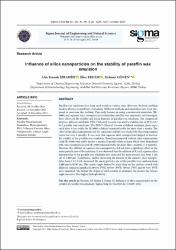| dc.contributor.author | İbrahim, Aliu Pennah | |
| dc.contributor.author | Erdem, İlker | |
| dc.contributor.author | Gönen, Mehmet | |
| dc.date.accessioned | 2024-02-01T13:54:46Z | |
| dc.date.available | 2024-02-01T13:54:46Z | |
| dc.date.issued | 2023 | en_US |
| dc.identifier.issn | 1304-7205 | |
| dc.identifier.issn | 1304-7191 | |
| dc.identifier.other | WOS:001102600300007 | |
| dc.identifier.uri | https://doi.org/10.14744/sigma.2022.00049 | |
| dc.identifier.uri | https://hdl.handle.net/20.500.12573/1917 | |
| dc.description.abstract | Paraffin wax emulsions have been used widely in various areas. However, the basic problem faced in all areas is instability of emulsion. Different methods and emulsifiers have been proposed to overcome this problem. This study focuses on using a commercial emulsifier, (IK8000) and aqueous silica nanoparticles to formulate paraffin wax emulsions and investigate their effects on the stability and mean diameter of paraffin wax emulsions. For comparison purpose, different emulsifier, PEG-7 Glyceryl Cocoate was used to stabilize one of 20 % (wt./ wt.) paraffin wax emulsions. The PEG-7-Glyceryl Cocoate stabilized emulsion phase -separated after 3 days while the IK-8000 stabilized remained stable for more than a month. The effect of the silica nanoparticles on the emulsion's stability was studied by observing samples stored for over 2 months. It was seen that aqueous silica nanoparticles helped to increase the stability of the paraffin wax emulsions. Emulsions prepared without silica nanoparticles (only IK-8000) were stable for just a month (1 month) whereas those which were formulated with silica nanoparticles and IK-8000 remained stable for more than 2 months (> 2 months). However, the addition of aqueous silica nanoparticles did not have a significant effect on the mean particle size of the emulsion. It was observed that the addition of 0.5 mL aqueous silica nanoparticles to the paraffin wax emulsion first increased the mean particle size from 1.142 mu m to 2.680 mu m. Nonetheless, further increasing the amount of the aqueous silica nanoparticles from 1.0-5.0 mL decreased the mean particles size of the paraffin wax emulsion from 2.680 mu m to 0.942 mu m. The contact angle formed by water drop on the surfaces coated with different emulsion samples of 30%wt. PWE, 40%wt. PWE, 50%wt. PWE and 60 %wt. PWE were measured. The higher the degree of solid content in emulsion, the greater the contact angle measured thus higher hydrophobicity. | en_US |
| dc.description.sponsorship | Department of Scientific Research Projects (BAP) of Sueleyman Demirel University FYL-2020-8136 | en_US |
| dc.language.iso | eng | en_US |
| dc.publisher | YILDIZ TECHNICAL UNIV | en_US |
| dc.relation.isversionof | 10.14744/sigma.2022.00049 | en_US |
| dc.rights | info:eu-repo/semantics/openAccess | en_US |
| dc.subject | Paraffin Wax Emulsion | en_US |
| dc.subject | Emulsifiers | en_US |
| dc.subject | Hydrophobicity | en_US |
| dc.subject | PEG-7 Glyceryl Cocoate | en_US |
| dc.subject | Silica Nanoparticles | en_US |
| dc.subject | Contact Angle | en_US |
| dc.subject | Emulsion Stability | en_US |
| dc.title | Influence of silica nanoparticles on the stability of paraffin wax emulsion | en_US |
| dc.type | article | en_US |
| dc.contributor.department | AGÜ, Mühendislik Fakültesi, Malzeme Bilimi ve Nanoteknoloji Mühendisliği Bölümü | en_US |
| dc.contributor.authorID | 0000-0001-5743-0835 | en_US |
| dc.contributor.institutionauthor | Erdem, İlker | |
| dc.identifier.volume | 41 | en_US |
| dc.identifier.issue | 5 | en_US |
| dc.identifier.startpage | 1029 | en_US |
| dc.identifier.endpage | 1041 | en_US |
| dc.relation.journal | SIGMA JOURNAL OF ENGINEERING AND NATURAL SCIENCES-SIGMA MUHENDISLIK VE FEN BILIMLERI DERGISI | en_US |
| dc.relation.publicationcategory | Makale - Ulusal Hakemli Dergi - Kurum Öğretim Elemanı | en_US |


















